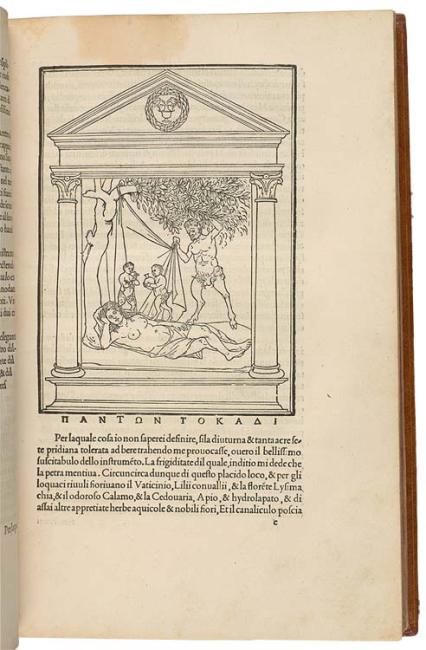
Attributed to Francesco Colonna
(1433–1527)
Hypnerotomachia Poliphili (Poliphilo's Strife of Love in a Dream)
Printed by Aldus Manutius in Venice, 1499
Opening: Nymph Discovered by a Satyr
Purchased by Pierpont Morgan with the library of Theodore Irwin, 1900
PML 373
Because of its elegant page layout, roman typeface, and refined woodcut illustrations, this famous example of early printing has been called the most beautiful illustrated book printed in Italy in the fifteenth century. The woodcuts are thought to have been designed by Benedetto Bordone, a successful miniaturist who turned to new artistic activities in the age of printing.
Written as an allegorical romance, the Hypnerotomachia tells of Poliphilo, who pursues his love, Polia, through a dreamlike landscape. The nymph discovered by a satyr shown here is thought to have inspired Giorgione's painting of around 1510, Venus Reclining (Dresden), considered the first painting of a female nude since antiquity.
Printing
In 1469—some fourteen years after Johannes Gutenberg printed a bible using movable type—this transformative technology arrived in Venice, and the city rapidly became Europe's preeminent center for book publishing. During the last few decades of the fifteenth century, a new kind of volume appeared: the hand-illuminated printed book. Trained scribes and artists carefully added chapter headings, initials, borders, and lavish frontispieces to the printed text. These luxury items were created for a wealthy and prominent clientele—predominantly Venetian nobility.
The impossibility of hand decorating ever-increasing numbers of books led Venetian printers to adopt mechanical means to embellish their printed texts. From the 1490s, it became common to illustrate books by incorporating woodcuts. As the market for printed material flourished, artists such as Titian and Battista Franco produced masterly woodcuts and engravings to enhance their reputations.
